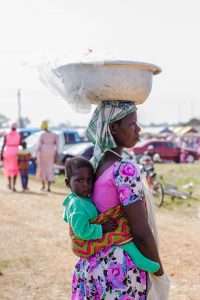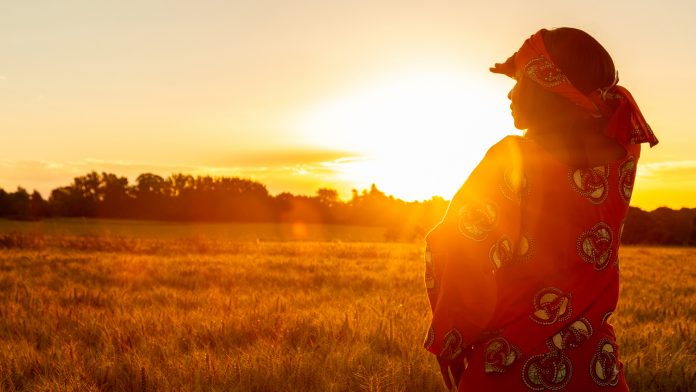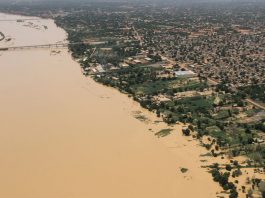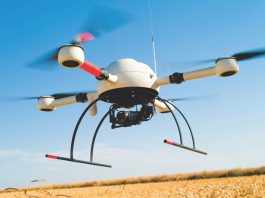RSS Hydro Geoscientist & UAV Pilot Margherita Bruscolini discusses the links between the climate crisis and societal inequalities in Niger, affected by migration, gender, socio-economic differences, and security factors.
Climate change and its impacts on people and the planet were once perceived as something quite abstract and far from everyday life. However, when analysing the links between the climate crisis and society, it is becoming a familiar and quite scary reality for each of us. News about the climate crisis and new analysis and scientific findings surrounding climate change are being covered regularly by traditional and modern social media channels, highlighting the gravity of the unprecedented time we live in.
When discussing the changing climate, undeniably accelerated by human activities, it is easier to simplify the situation with a sectorial gaze and consider the causes and effects on limited geographies or social groups. After all, looking at the bigger picture tends to be a challenging job, especially in the interconnected and multifaceted world we live in, where climate and environmental issues are just one of the many challenges we face.
However, working on projects linked to climate change, such as the aid development project in Niger1, challenges one to look beyond their main professional focus area of activity and push the boundaries of their comfort zone, assuming a proactive and multidisciplinary approach.
Analysing the climate crisis and societal inequalities in Niger
The climate crisis is a global disruption, posing uncertainty on all levels and is by far the main challenge of our times, so it makes sense to approach it from different points of view. Being open to starting the discussion of climate change from the needs of the populations, their initiatives, and indigenous knowledge is fundamental to defining the means and interventions likely to strengthen their resilience to climate change and environmental degradation.
It is also essential to promote gender-based approaches to identify the most relevant actions for women, young people, and other vulnerable groups while considering their socio-economic roles and productive activities. This allows them to be directed toward removing barriers to their social and economic participation. Collaborating with professionals from different countries, cultures, and age groups is beneficial personally and professionally. It gives them the ability to analyse issues from different perspectives and find new solutions at the intersections between them.
We often forget to explore the connection between the climate crisis and society, analysing factors such as migration, gender, socio-economic differences, and security factors. They can appear distant and unconnected but are now more than ever interlinked. As highlighted in the latest national study on the nexus between migration, environment, and climate change in Niger,2 environmental degradation and climate change factors play a crucial role in migration dynamics, exposing the existing link between these critical aspects.
Different perspectives of climate change effects
People from different regions, genders and age groups were interviewed and asked about various aspects of climate change and their perception of associated effects on the environment and society. The results delineate a clear picture of the importance of the changing climate in everyday life. For example, many people surveyed noted changes in the availability of natural resources, such as agricultural land and water, and a recent increase in migration of the local population (especially young active people) in almost all regions of the country.
There is evidence that humans have lived in a narrow subset of Earth’s available climates for thousands of years, which some call a ‘climate niche’. These climates are characterised by mean annual temperatures between 11°C and 15°C,3 and the population distribution is changing, reflecting a human temperature niche related to fundamental constraints.
The study by Chiu et al. (2020) demonstrates that depending on population growth and global warming scenarios, over the coming 50 years, one to three billion people are projected to be left outside the optimal climate conditions. A link between the changing climate and migration patterns and the current production of crops and livestock appears clear, with certain temperature limitations.

The Chiu study3 demonstrates that in the absence of migration, one-third of the global population will probably experience a mean annual temperature of more than 29°C, currently found in the Sahara. Nevertheless, migration dynamics can also be recorded from rural villages to urban areas or capitals, especially during the dry season, where the commercial, industrial and educational activities offered elsewhere are vaster. As the world’s poorest regions are potentially the most affected by the climate crisis, where adaptive capacity is low and environmental changes pose a real threat to resilience, enhancing human development should be a priority alongside climate mitigation.
Analysing the social inequalities that are linked to the climate crisis and society
Cultural, social, and religious norms can aggravate the situation of vulnerable people and communities, exposing pre-existing inequalities. In rural Niger, for example, women face an overlap of vulnerabilities against a backdrop of economic and social inequalities endorsed by cultural and gender norms and religious beliefs.2
The responsibility for cooking, cleaning, and caring for family members falls heavily on women, translating into much work. This is exasperated in contexts where the majority of men migrate, increasing the work that women need to do to compensate for their absence.
Climate change and environmental degradation, with associated migration, can only amplify the constraints experienced by women in carrying out activities of a domestic nature. This especially affects women connected with the use of natural resources, such as progressively scarce water supply and fuelwood. Women’s capacity to respond to disasters is diminished because the skills and knowledge needed to cope with them are taught more to men than to women, who are instead confined to the domestic sphere. In addition, extreme weather events such as floods, drought, and wildfires can also generate stress and frustration, impacting family relations and leading to gender-based violence.
Gendered experiences of climate change
Globally, women and men experience the effects of climate change differently. As women experience a lack of equity in the distribution of power and resources and poor access to equipment and education, alongside an increase in their household management responsibilities, the gender inequalities remain fixed. Therefore, women find themselves in a position of double vulnerability, using urban migration as a means of adaptation.
In the study in Niger,2 climate change is perceived in different ways, with around 71% of the participants attributing it to God’s work, highlighting the influence of religious norms. Moreover, the migration of family members has been highlighted as one of the main coping strategies for climate change and environmental degradation in Niamey.2
The climate crisis and environmental degradation are urgent issues to tackle and fight to achieve sustainable development. Recurrent floods are devastating for the population of Niger2 because they cause loss of life and destruction of habitats, food, and land necessary for cultivation. They generate forced displacements and require the implementation of planned relocation and disaster risk management actions that test Niger’s public authorities every year.
Climate crisis mitigation avenues
In conclusion, some of the key avenues to be taken into account to improve the resilience of vulnerable communities to the effects of the climate crisis and society include developing rural and urban localities, improving living conditions, encouraging the emergence of sustainable empowerment dynamics among women and young people and promoting income-generating activities with a focus on environmental preservation. The responses of the public authorities require that stakeholders (governments, civil society organisations, development partners, etc.) coordinate their actions to achieve a planned adaptation that is capable of taking into account the close links between migration, the environment and climate change.
References
1. Space-Enabled Modeling of the Niger River to Enhance Regional Water Resources Management (SEMOR), Margherita Bruscolini, RSS-Hydro, 2021.
2. National study on the nexus between migration, environment and climate change in Niger, IOM UN migration, IOM development fund, 2021.
3. Future of the human climate niche, Chi Xu et al., Proceedings of the National Academy of Sciences (PNAS), 2020.









